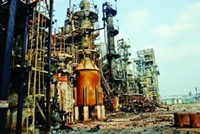Advertisement
Grab your lab coat. Let's get started
Welcome!
Welcome!
Create an account below to get 6 C&EN articles per month, receive newsletters and more - all free.
It seems this is your first time logging in online. Please enter the following information to continue.
As an ACS member you automatically get access to this site. All we need is few more details to create your reading experience.
Not you? Sign in with a different account.
Not you? Sign in with a different account.
ERROR 1
ERROR 1
ERROR 2
ERROR 2
ERROR 2
ERROR 2
ERROR 2
Password and Confirm password must match.
If you have an ACS member number, please enter it here so we can link this account to your membership. (optional)
ERROR 2
ACS values your privacy. By submitting your information, you are gaining access to C&EN and subscribing to our weekly newsletter. We use the information you provide to make your reading experience better, and we will never sell your data to third party members.
Safety
Getting The Toxics Out
NRC looks at methyl isocyanate and how chemical companies can cut use, storage of toxic materials
by Jeff Johnson
February 21, 2011
| A version of this story appeared in
Volume 89, Issue 8

The first meeting of a new National Research Council (NRC) panel, held this month in Washington, D.C., zeroed in on two deadly chemical plant accidents that took place worlds apart, both in years and miles, but shared a singular threat: methyl isocyanate (MIC)—a highly reactive, valuable, and extremely toxic chemical.
The panel was created last year by Congress in response to the 2008 accident at the Bayer CropScience plant in Institute, W.Va. Its charge is to look at how MIC is used and stored at the plant, how MIC could be eliminated, and how inherently safer design approaches could help make plant processes safer. Like many chemicals used in manufacturing, MIC has been a useful manufacturing intermediate, but it is also deadly.
In 1984, a cloud of MIC swept through the city of Bhopal, India, killing thousands of residents living on the fence line of a Union Carbide plant; more than 25 years later, in August 2008, the accident at the Bayer CropScience plant killed two workers and forced 40,000 people to shelter in place, sealing home doors and windows, when an explosion blasted debris within feet of a large MIC storage tank. No MIC was found to be released at the Institute plant, but the near-miss angered local officials and community residents. The plant abuts homes and a university, and since the Bhopal incident, community members had pressed Bayer and two previous plant owners to eliminate MIC.
Shortly after the accident, the Chemical Safety & Hazard Investigation Board (CSB) began an investigation, and Congress stepped in and appropriated $600,000 for the NRC review. The report from the NRC panel is due in September.
However, a month ago, Bayer announced that it would phase out its use of MIC at Institute over the next 18 months (C&EN, Jan. 17, page 24). The announcement came a week before CSB was to release what turned out to be a scathing report blaming the company for causing the 2008 accident. Now, several weeks later, NRC is beginning its review (C&EN, Jan. 24, page 7).
Because Bayer plans to phase out MIC, the context of the study has changed, notes Kathryn Hughes, an NRC program officer. The situation at Bayer will become a case study of approaches to make chemical plants safer, including the application of inherently safer technologies, she notes.
The concept of inherently safer chemical manufacturing was developed and promoted by Trevor Kletz, a U.K. chemical engineer, who described a goal of minimizing use and storage of toxic, flammable, or explosive chemicals in manufacturing through a host of means, including chemical substitution and process modifications. The end goal is to engineer a fail-safe process to eliminate or at least minimize a potential accident’s impact.
Its use has been controversial. Some companies say it should be encouraged but never required, and community groups say it always should at least be considered by companies that process large amounts of dangerous materials.
Into this debate steps the 10-member panel of chemical engineers, chemists, and economists, with a sprinkling of risk-assessment experts and health professionals.
At the first meeting, the panel heard about Bayer’s difficulty in phasing out MIC. Steven Smythe, a Bayer chemical engineer, said the company examined four production alternatives to eliminate or reduce storage and use of MIC, including one developed and deployed by a DuPont plant seven months after the Bhopal accident. None of the approaches, however, was adequate for Bayer, he said.
Since the 2008 accident, Bayer has reduced the amount of MIC stored at Institute by 80%, he said. It had stored nearly three times the amount leaked in Bhopal. Even with the reduction, the company still stores about 48,000 lb of MIC on-site, more than half of the 88,000 lb thought to have leaked in Bhopal.
The phaseout decision was not driven by safety, Smythe said. Instead, it was based on “strategic and economic considerations” and a global corporate effort to replace aging pesticides with new compounds. Bayer will eliminate products using carbamate chemistries that depend on MIC, according to him.
Smythe explained that such carbamate products lack a “long time horizon” and more company investments could not be justified, hence the decision to eliminate the pesticide products.
“We believe we’ve got a safe system at Institute,” he continued, “but in the end, the announcement of this January that we are going to stop making MIC in West Virginia makes this point moot.”
The DuPont model, Smythe said, “looked good economically, but there were questions we can’t answer, and that is why we stayed with our technology—because it is known, trusted, and proven.”
However, DuPont saw things differently. In 1984, John B. Carberry was DuPont’s director of process R&D for agricultural chemicals, and it fell to him to develop the company’s response to Bhopal. DuPont, too, used MIC in pesticide production.
Speaking at the NRC meeting, Carberry said: “I remember the day extremely well. The accident occurred on Dec. 3, 1984, at 1 AM; it was 3 PM in the eastern U.S. There was high-profile media coverage by the then-new Cable News Network. There were between 1,500 and 8,000 immediate deaths. We figured DuPont shipments of MIC would be stopped in the U.S. for a good long time. We were wondering how we will stay in business.”
At the time, DuPont was dependent on MIC that was made at a non-DuPont factory in Belle, W.Va., and shipped to DuPont’s LaPorte, Texas, facility, where it was used to formulate two pesticides that were a strong business for DuPont, Carberry explained. The company had but a few months’ worth of MIC. “It was a grim picture,” he said. “We knew the company could no longer ship or store MIC on-site in large quantities.”
Carberry, who retired from DuPont in 2007, described a commitment by senior engineers to develop a new manufacturing method using, basically, a just-in-time production system that tied two reactors together, one formulating MIC and the other using it. “We had MIC in a pipe that was only a few feet long and carried between 0.5 and 2 lb of MIC at any time.”
They got the process working in June 1985, six months after Bhopal. Carberry credits the commitment by company engineers, a “model” plant manager at LaPorte who had support from regulators and the community, and a highly motivated company that wanted to address MIC use.
DuPont did not eliminate MIC, several panel members noted, but they made the process safer and eliminated nearly all MIC storage. Why DuPont made these changes and Bayer did not is sure to be discussed as the panel continues its investigation. Next month the panel goes to Institute.
The meeting there is likely to draw considerable interest. A week ago, 16 residents sued to stop Bayer from restarting production units that still use MIC. Those units had not been in operation since the 2008 accident. And on Feb. 10, a day after the NRC meeting, a U.S. district court judge agreed, issuing a temporary restraining order blocking Bayer from restarting the units for 14 days while lawyers prepare for trial, the Charleston Gazette reports. On Feb. 11, residents’ lawyers sued Bayer to receive the background material the company developed on alternative processes that it revealed at the NRC hearing.




Join the conversation
Contact the reporter
Submit a Letter to the Editor for publication
Engage with us on Twitter